June 30, 2018
List of Blogs
|<
<
>
>|
|
|
Growing Edible Native Plants: Do's and Don't's
|
|
There are lots and lots of native edibles plants, and some of them are downright delicious.
Foraging has become increasingly popular in recent years, so why not just grow your own
native plants and forage at home? This helps to preserve native populations of edible
plants which, in some cases, are becoming quite rare due to
human interference. And who
doesn't want to grow gardens they can eat out of? Walking out your back door and eating
some fresh berries or plucking some leaves to make your own tea - doesn't that sound lovely?
There are many different ways to enjoy edible native plants. You can eat them fresh (many nuts,
berries, and larger fruits), and you can also process some to produce candies, beers, vegetable
dishes, and even use some of them as spices while cooking We will talk about as many of them as
we can in this post, but first...
|
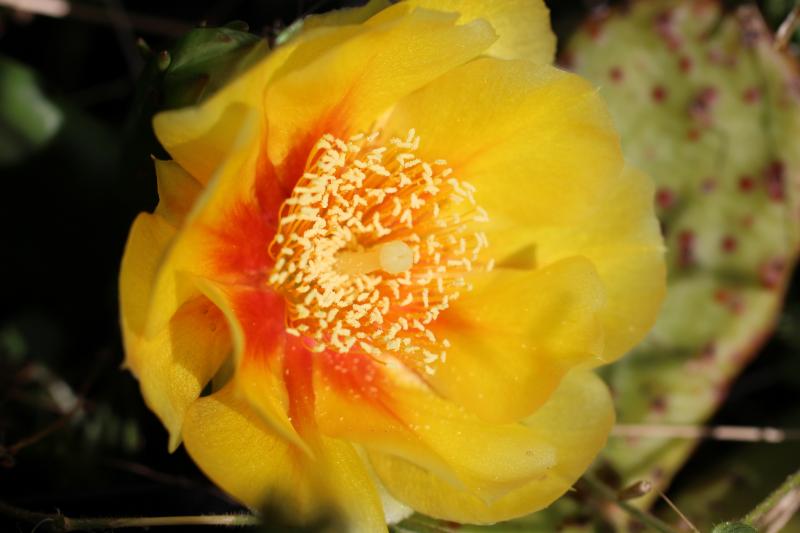
Some plants are edible that you might not expect,
such as Eastern Prickly Pear Cactus (Opuntia humifusa). But do be careful of both the large
spines and the equally fierce tiny glochids (hair-like barbed spines) as you prepare them!
|
|
A Serious Word of Caution:
There are three things you need to be aware of before getting involved with edible plants.
First, know your plants: just because something is natural and native, doesn't mean it's
automatically safe to eat, and some edible plants have poisonous look-alikes. You don't
want to be that person who decides to snack on Jack-in-the-Pulpit (Arisaema triphyllum)
berries ("look at those bright red berries in the woods - they must be delicious!") and
has to be rushed to the emergency room for very painful calcium oxalate poisoning (we
actually know people who have done this).
|
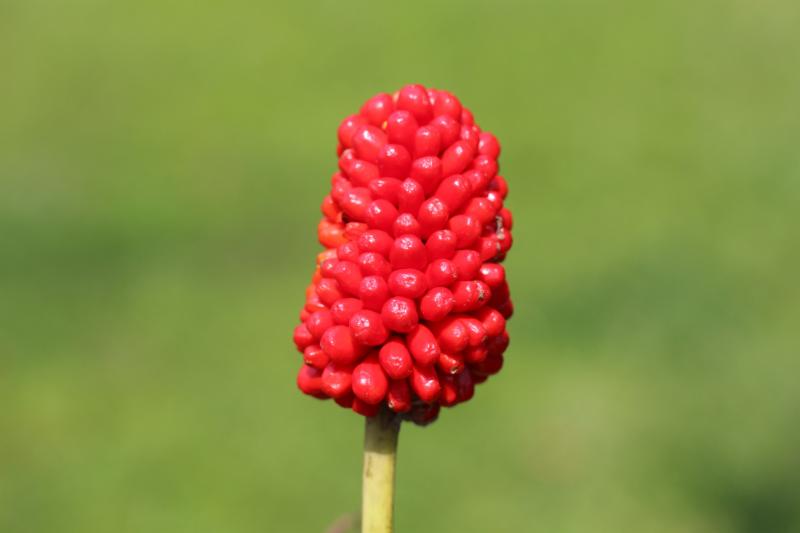
Pictured: very showy, but not edible(!) Jack-in-the-Pulpit
(Arisaema triphyllum) berries.
|
|
Jack-in-the-Pulpit is not edible without some serious processing, but even the tamest-seeming
edible plants often require some level of processing before they can be safely eaten (look
up cashew processing sometime, you'll never look at them the same way again). This brings us
to our second point: know what parts of the plant to avoid, and know what edibles need processing
before you can eat them. For example, Cherry trees (Prunus sp.), delicious as their fruits are,
have high concentrations of cyanide in their pits, twigs, and leaves. Because we are typically
not involved in collecting and processing the plant products we buy in grocery stores, we often
take for granted that they are edible right off the plant (and that, by extension, plants we
grow ourselves to eat also shouldn't require any processing), but this is not always true.
There are certainly native edibles that don't require any processing at all. Many native
edibles are perfectly safe to eat right off the plant, but it's nice to be sure of that
before you pop them in your mouth: this is why research is your friend!
|
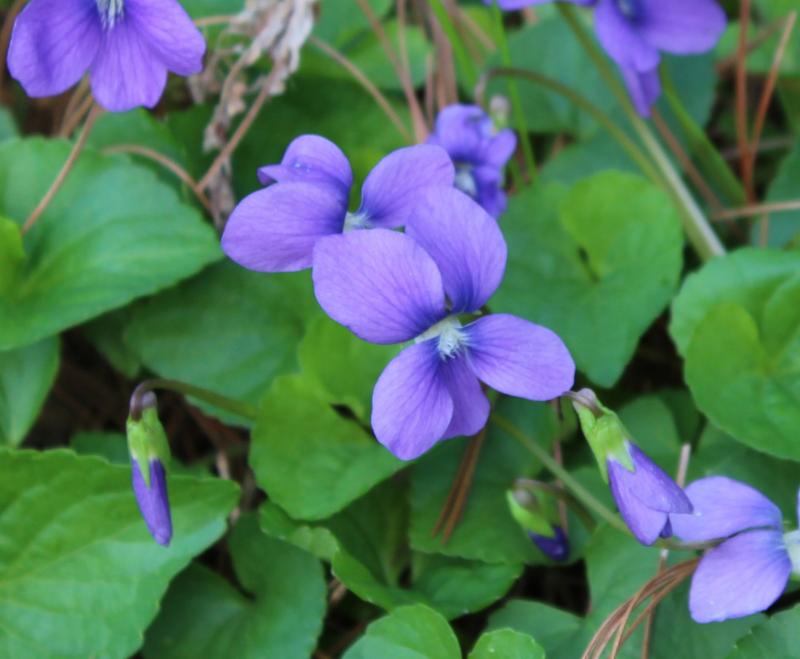
Violet flowers like these (Viola sororia) can make
for a pretty addition to salads, as well as an interesting ingredient for candies, extracts and liquors.
|
|
And third, before we get into talking about edible natives, a word about medicinal plants:
if you look at our catalogue of plants and then go to a health food store or local pharmacy,
you may recognize many of the names on the supplement shelves from the plants we sell,
but Toadshade is actively uninvolved in the medicinal plant business. We do not advocate
the use of our plants as medicinal supplements, because the untrained use of traditional
medicinal plants is quite dangerous. Some of the folks we encounter who have the most
enthusiasm for the medicinal value of plants aren't experienced in plant ID or processing
and have done very little research on possible drug interactions. It is important to note
that many medicinal plants are, in fact, extremely poisonous. Traditional medicinal plants,
including things as harmless-seeming as St. John's Wort (Hypericum sp.) (which has been
historically used as an antidepressant), have compounds in them as real as any medicine
you might take (prescription or otherwise), and they can have drug interactions just as
devastating. For example, consuming St. John's Wort while on any of the most common classes
of antidepressants (including SSRIs, SNRIs, tricyclics, and MAOIs), can cause serotonin
syndrome, which can be very dangerous. Even Willow (Salix sp.) bark, long used as a painkiller,
is dangerous for young children and people with certain blood conditions, as its active
compounds are very much like those in aspirin. Again, just because something is natural,
doesn't mean it can't be dangerous (note: arsenic, ricin, and cyanide are all natural
compounds).
|

Some native edibles are also quite showy, like Purple Flowering
Raspberry (Rubus odoratus), which puts on quite a spectacular show through the first half of the summer
before producing edible raspberries.
|
|
So What IS Good??
Lots! An apology for all the gloom and doom: we certainly don't want to discourage anyone from
growing and trying their own edible plants, but as with the two fellows we know who ate raw
Jack-in-the-Pulpit berries, we sometimes meet people just beginning to get into edibles who don't
know enough about the subject to exercise reasonable levels of caution, so we wanted to get that
out of the way first. So what IS good? A better question would be "where to begin?" There are many,
many native plants with edible parts, and we can't possibly cover them all here, but let us introduce
you to some edible natives that perhaps you haven't thought of before.
|
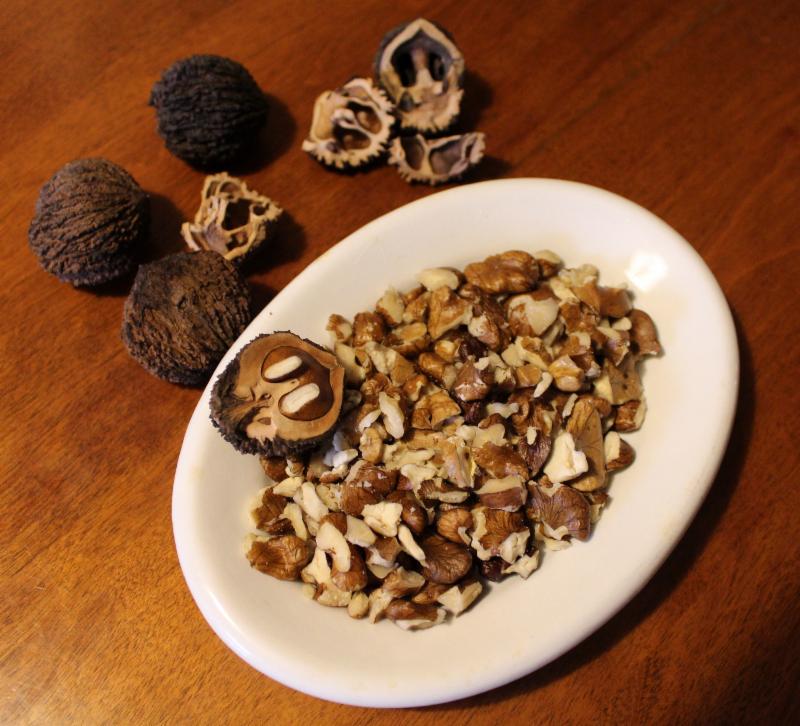
Black walnuts (Juglans nigra) are as tasty as
English Walnuts (Juglans regia) that you buy in a store, and they're gorgeous trees that
rain down showy yellow leaves in the fall.
|
|
Nuts and Tubers
So many nuts, so little time. There are many types of nuts produced by native trees that are
edible to humans: Black Walnuts (Juglans nigra), for example, are quite delicious. The
trick is getting these tough nuts open (it can be a really fun activity to do with children):
we typically find a nice flat rock outside and employ a hammer (or even another rock) to get
the job done. I remember enjoying quite a feast of them for the first time when I was about
12 years old camping in Maryland - my hands were stained from the husks but I shall never forget
the experience. Hickory (Carya sp.) nuts are edible too, although certain species of
hickory taste better than others (hint: Bitternut Hickory (Carya cordiformis)
comes by its name honestly). Shagbark Hickory (Carya ovata) nuts taste as good as
Pecans (Carya illinoinensis), which are simply a species of Hickory tree native to
certain portions of the Southeast. In fact, if you're feeling ambitious, there's no reason you
can't make a pecan pie with the meat of Shagbark Hickory nuts! American Filbert (Corylus americana)
nuts are also excellent, if you can get them them before the squirrels and chipmunks (good
luck with that). Tubers are often an overlooked edible resource as well. Broad-Leaved Arrowhead
(Sagittaria latifolia), also known as Duck Potatoes, produces quite a lot of small, tasty
tubers (and yes, ducks really enjoy them, too). Be cautious when digging tubers, however - these
are part of the plant's roots, so don't be greedy or you'll have no plants next year!
|
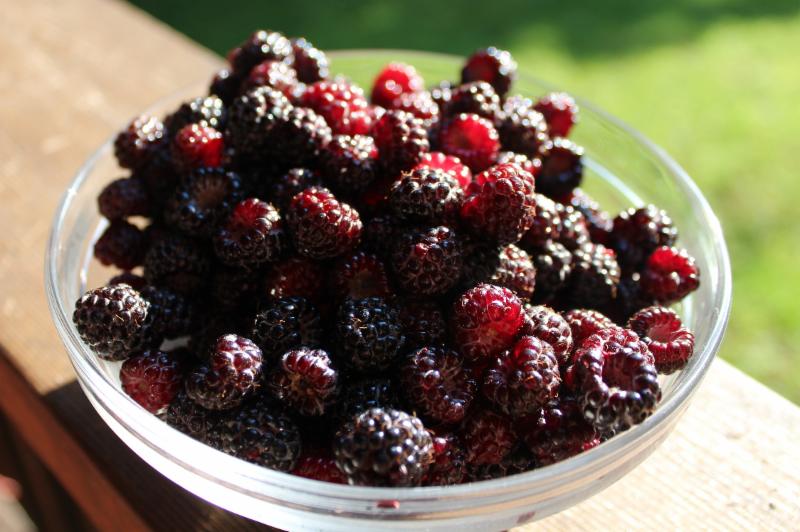
Black Cap Raspberries (Rubus occidentalis) are
delicious fresh, but they also freeze well, and can be made into baked goods like tarts and pies.
|
|
Berries
There are a great number of native plants with edible berries. Chokeberries (Aronia sp.),
which get their unfortunate common name from the fact that their berries are tangy and sour,
can be eaten directly off the bush in late summer. Wild Strawberries (Fragaria virginiana)
produce perfectly edible strawberries in the early summer, and when they finish up in midsummer,
native raspberry and blackberry species (Rubus sp.) pick up the slack. Black Cherry trees
(Prunus serotina) produce an abundance of edible cherries in late summer (although as
with all cherries, avoid pits and stems), and Wild Grapes (Vitis sp.) are equally edible.
Elderberries (Sambucus nigra), although they must be processed (cooked) before eating,
can make some very tasty summer treats (Elderberry syrup, wine, or pie anyone?). With berries,
the main limit is your creativity - for many years, we've been making wild grape jelly from
Summer Grapes (Vitis aestivalis), which is absolutely delicious. We also make a remarkable
cobbler out of Black Cap Raspberries (Rubus occidentalis) in early summer, and you can
use any of these berries to make a salsa or chutney, syrup, pie, muffins, scones, cookies,
mead, wine, jam, ice cream, tea, or even beer! And when you're done cooking, why not garnish
the end result with edible wild Violet (Viola sp.) or Spiderwort (Tradescantia sp.)
flowers? They can be frozen into ice cubes, or candied and put on top of baked goods as a
decoration. They can even be frozen in a jar and kept after they've been candied so you can
have them on hand to brighten up your food displays in the dead of winter.
|
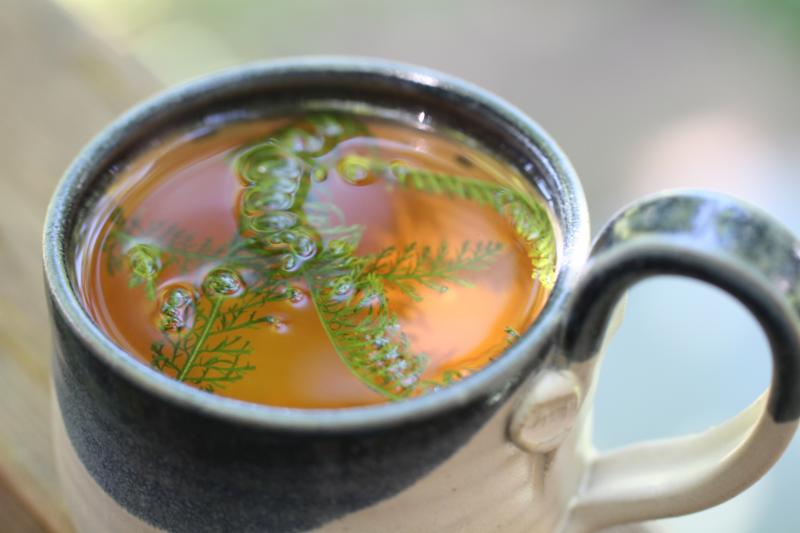
Common Yarrow (Achillea millefolium) makes
a delicious, attractive tea
|
|
Drinkables
One of the easiest things you can do to enjoy native plants as a drink is to simply make herbal
tea with them. Mountain Mints (Pycnanthemum sp.) have an excellent mint flavor when their
leaves are made into a tea, and Yarrow (Achillea millefolium) leaf tea is sweet and
flavorful (my personal favorite). Wild Bergamot (Monarda fistulosa) tea tastes almost
just like Earl Grey and Spicebush (Lindera benzoin) tea made out of the green
branch tips is fantastic. On the subject of beer, yes, you can make beer out of native plants.
Native hops (Humulus lupulus var. lupuloides) work just like commercial ones,
and if you're into homebrewing, there are plenty of potential ingredients you get from native
plants that you can use to flavor your beer. We even made some lovely beer flavored with
Eastern Prickly Pear Cactus (Opuntia humifusa) fruits one year (technically it was
not a beer, but a Melomel - because it contained fruit). You can also make juice from many
of the berries we've discussed, and Staghorn Sumac (Rhus typhina) seed heads can be
made into a refreshing pink midsummer 'lemonade'! if you're into making liquors, it's quite
simple to make a variety of liquor flavors from various native plant ingredients. You can even
use Violets (Viola sp.) and Elderberry (Sumbucus nigra) flower petals (do your
research on elderberry flowers first - like cherries, Elderberry plants contains toxins,
so you want to only use the flower itself, and no stem parts at all) to make some gorgeous,
interesting liquors very easily.
|
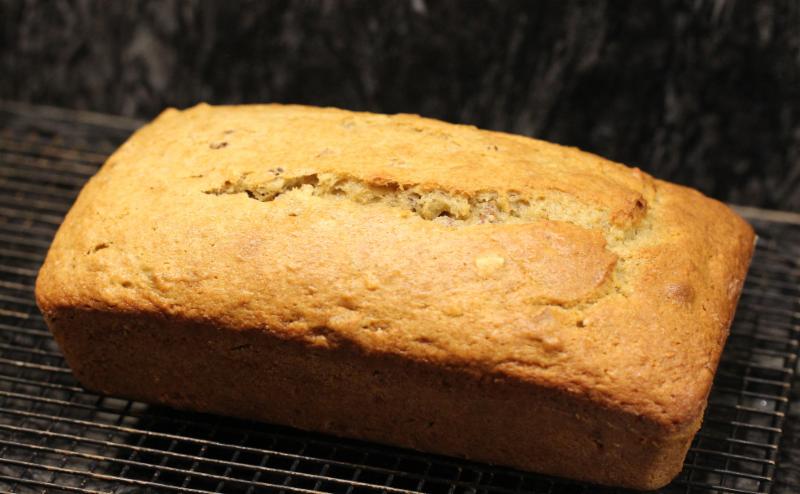
Pawpaw (Asimina triloba) fruits can be eaten
out of hand or baked into delicious bread (similar to banana bread). They can also be made
into an excellent Pawpaw meringue pie (oops - we ate the pie too fast and forgot to take a picture).
|
|
Spices, Veggies & Fruits, Oh My!
This is just a partial list of native foods that you can grow and eat out of your own garden.
We could go on all day; the dried, powdered leaves of native Sassafrass trees (Sassafras albidum)
are known as filé powder (aka gumbo filé), a traditional table condiment served alongside gumbo, and
Spicebush (Lindera benzoin) berries can be effectively used as an allspice substitute.
Young shoots of Ostrich Fern (Matteuccia struthiopteris) and Round-leaved Catbriar
(Smilax rotundifolia) can be cooked and eaten like asparagus (and are very tasty),
and Nodding Onion (Allium cernuum) can be used like a strong onion or garlic for
flavoring. Pawpaw (Asimina triloba) fruits taste somewhat like banana pudding, and
can be eaten right after they fall off the tree when soft and ripe (we've found the easiest
way to eat them is to scoop the flesh out of the skin with a spoon), as can the fruits of
Persimmon trees (Diospyros virginiana) (make sure to wait until after the first frost
to eat Persimmon - they are intensely puckery if not ripe). You can even make candies out of
Angelica (Angelica venenosa), Canadian Wildginger (Asarum canadense), and
Filbert Nuts (Corylus americana). The possibilities are somewhat endless to be honest,
but as noted above, it's important to do your own research, so that you can enjoy the edibles
in your garden safely and with confidence!
|
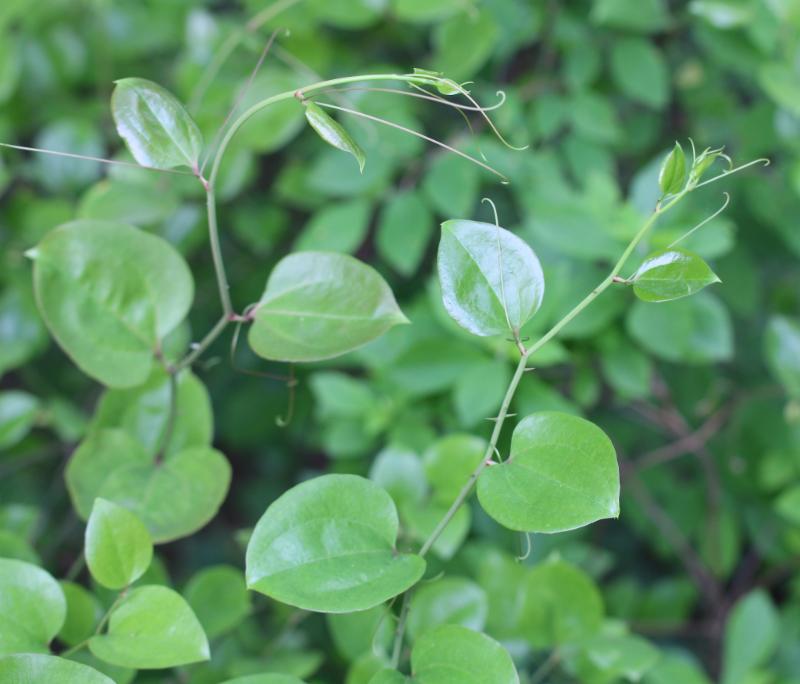
Round-leaved catbriar (Smilax rotundifolia)
is a showy semi-evergreen vine, and the young shoots are quite tasty!
|
|
|



